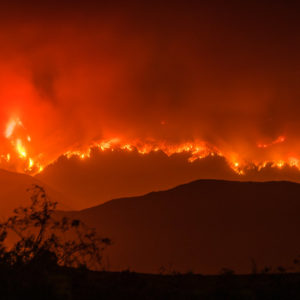Wildfires aren’t just for summer anymore. In the West and Southwest, the fire season will begin earlier this year and last longer.
If you live in a western state, take heed: That adorable cottage of yours in the woods may be consumed in flames. Small towns may feel the heat of nature’s wrath. The threat and consequences are real.
The drought that began two decades ago continues; it just gets a bit worse each year.
That is the collective view of a group of western utility executives and an eminent long-range weather forecaster who participated in a virtual press briefing which I organized and moderated for the United States Energy Association.
The prognosis of a long, hot fire season beginning in spring and extending into fall was delivered by Paul Pastelok who leads the team of long-range forecast scientists at AccuWeather.
He said, “We feel with confidence that the drought will cover a large section of the western U.S. and will extend out into the Plains, similar to the trend we saw in 2018. The Northern Plains, Four Corners region, are going to experience some pretty extreme drought but for a shorter period of time.”
The good news, if there is any, is that the authorities – yes, them — are working on mitigation in wide-ranging cooperation between the Electricity Subsection Coordinating Council (ESCC), the influential but little-known, CEO-led utility organization which liaises with government departments on cybersecurity and other issues.
In this instance, the cooperating departments include the Department of Energy and some of its national laboratories; the Agriculture Department’s Forest Service; the Department of Transportation; the Department of Homeland Security’s Federal Emergency Management Agency; and the Federal Aviation Administration.
Maria Pope, president and CEO of Portland General Electric, said she would like the FAA to expedite its regulations for drones, which are used to surveil utility lines and will be on the front lines.
But the brunt of the fire onslaught will be borne by communities and their fighters with help, where possible, from the states. Think the National Guard.
The ESCC has a wildfire working subcommittee which is headed by Pope, a star in business circles and a key figure in wildfire management. Not only does she head a utility that has been in the eye of the storm but earlier in her career, she was an executive in the forest products industry. She knows the forest as a benefactor and a malefactor.
For utilities, the issues are multiple. Many wildfires start with trees in high winds landing on power lines that arc and spark when they hit the ground.
If the forest floor is tinder dry, the result is known. Last year a late-season fire, on Dec. 30, started in the Boulder area and destroyed 1,000 homes. The cause of the fire hasn’t been identified positively.
After the threat to life and property has subsided, and the fires have either burned out or been extinguished, the painful inquests begin with accusations often directed against the power companies because they are large and visible and can be sued.
But fires start in many ways. There is, indeed, the issue of arcing and sparking from utility lines. But there is also, as Pastelok noted, lighting and hundreds of activities that can go wrong from burning refuse to picnic fires and, sadly, arson.
Technology is increasingly important in identifying the root cause and mitigation of fires. This includes data management coming from smart meters; better line surveillance with drones and sensors; and instant communications, so that if a line fails, it can be de-energized instantly, maybe in one second.
Ruth Marks, who manages distribution for the Denver-based Tri-State Generation and Transmission Association, said “problem trees” – dying or dead trees near a power line — need to be identified and harvested. She also said the fire season now lasts the whole year, from January to December. Sobering.

